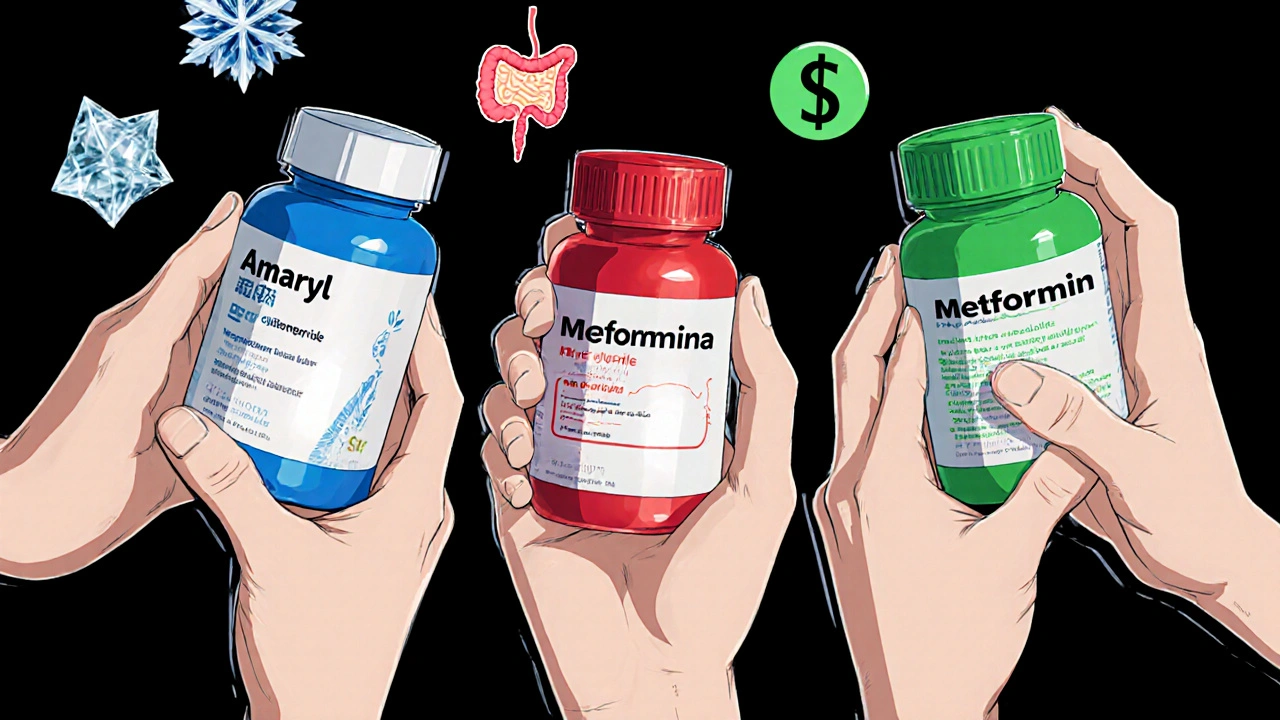Diabetes Medication Comparison Calculator
Personalize Your Comparison
Answer a few questions to see how medications compare for your situation.
Personalized Recommendations
Amaryl (Glimepiride)
Metformin
Empagliflozin
Sitagliptin
Living with type 2 diabetes means juggling blood‑sugar numbers, lifestyle tweaks, and a handful of pills. One name that often surfaces is Amaryl, but how does it really stack up against the other options on the market? This guide walks through the science, the side‑effects, and the real‑world costs so you can decide whether Amaryl (Glimepiride) is right for you or if another drug might be a better fit.
What is Amaryl (Glimepiride)?
Amaryl (Glimepiride) is a second‑generation sulfonylurea oral hypoglycaemic agent used primarily to lower blood glucose in people with type 2 diabetes. It works by stimulating pancreatic beta cells to release more insulin, which helps reduce fasting and post‑prandial glucose levels. Typical doses range from 1 mg to 8 mg once daily, taken with breakfast. The drug was approved in the 1990s and remains popular because of its once‑daily dosing and modest cost.
How Sulfonylureas Work
Sulfonylureas bind to the SUR1 receptor on beta cells, closing ATP‑sensitive potassium channels. This triggers calcium influx and insulin secretion independent of blood‑glucose levels. While this mechanism provides quick glucose lowering, it also raises the risk of hypoglycaemia, especially in older adults or those with irregular meals.
Key Factors to Compare When Choosing a Diabetes Pill
- Efficacy: Average reduction in HbA1c (%)
- Safety profile: Risk of hypoglycaemia, weight gain, cardiovascular impact
- Cost: Generic availability, insurance coverage, out‑of‑pocket price
- Dosing flexibility: Fixed‑dose vs titratable, frequency
- Kidney & liver considerations: Need for dose adjustment in impairment
Amaryl Compared with Other Sulfonylureas
Within the sulfonylurea class, Glimepiride isn’t the only player. Two other common agents are Glyburide and Gliclazide.
Glyburide (also called glibenclamide) is an older, first‑generation sulfonylurea that tends to cause more pronounced hypoglycaemia, especially in patients with renal dysfunction. It is usually prescribed in 2.5 mg to 10 mg once daily doses.
Gliclazide is a newer, second‑generation sulfonylurea that offers a slightly gentler glucose‑lowering effect and a lower hypoglycaemia risk compared with Glyburide. It’s often used in 30 mg to 120 mg once‑daily doses.
Amaryl vs Non‑Sulfonylurea Oral Agents
Because many patients eventually need a second drug, it’s useful to contrast Amaryl with other major oral classes.
Metformin is the first‑line biguanide for type 2 diabetes. It works by reducing hepatic glucose production and improving insulin sensitivity. Doses start at 500 mg once daily and can be titrated up to 2000 mg split‑dose. Metformin rarely causes hypoglycaemia but can cause gastrointestinal upset.
Sitagliptin belongs to the DPP‑4 inhibitor class. By blocking the dipeptidyl peptidase‑4 enzyme, it prolongs the action of incretin hormones, leading to glucose‑dependent insulin release. A typical dose is 100 mg once daily, with a low hypoglycaemia risk.
Empagliflozin is an SGLT2 inhibitor that promotes glucose excretion via the kidneys. It is taken as 10 mg or 25 mg once daily and offers added benefits for cardiovascular health and weight loss, though rare genital infections can occur.

Practical Decision Checklist
- Do you need a strong HbA1c drop (>1.0%)? Amaryl typically delivers a 1.0‑1.5% reduction, comparable to Glyburide and better than Metformin alone.
- Is hypoglycaemia a major concern? If yes, consider Metformin, Sitagliptin, or Empagliflozin, which have minimal risk.
- Do you have chronic kidney disease (eGFR <60 mL/min)? Reduce sulfonylurea dose or switch to Metformin (if eGFR >30) or an SGLT2 inhibitor (if eGFR >45).
- What is your budget? Generic Amaryl costs around AU$0.30 per tablet, Glyburide slightly cheaper, while newer agents like Empagliflozin can exceed AU$5 per tablet without subsidy.
- Are you concerned about weight gain? Sulfonylureas, including Amaryl, may cause modest weight gain; SGLT2 inhibitors often promote weight loss.
Summary Table
| Drug | Class | Typical HbA1c Reduction | Major Side Effects | Cost (AU$ per tablet) |
|---|---|---|---|---|
| Amaryl (Glimepiride) | Sulfonylurea | 1.0-1.5% | Hypoglycaemia, weight gain | 0.30 |
| Glyburide | Sulfonylurea | 1.0-1.4% | Higher hypoglycaemia risk | 0.25 |
| Gliclazide | Sulfonylurea | 0.8-1.3% | Moderate hypoglycaemia, weight gain | 0.35 |
| Metformin | Biguanide | 0.6-1.0% | GI upset, lactic acidosis (rare) | 0.15 |
| Sitagliptin | DPP‑4 inhibitor | 0.5-0.8% | Nasopharyngitis, rare pancreatitis | 2.00 |
| Empagliflozin | SGLT2 inhibitor | 0.6-0.9% | UTI, genital mycotic infections | 3.50 |
When to Stick with Amaryl
If you’re already stable on Amaryl, have no recent hypoglycaemia episodes, and your kidney function is normal, there’s often no need to change. The drug’s low price and once‑daily dosing make it a convenient backbone for many patients, especially when combined with Metformin.
When to Switch Away
Consider moving to a different class if you experience any of the following:
- Frequent low‑blood‑sugar events, especially at night.
- Unwanted weight gain exceeding 2-3 kg.
- Renal impairment that limits safe sulfonylurea dosing.
- Cardiovascular concerns where an SGLT2 inhibitor could add benefit.
Final Thoughts
Choosing the right diabetes medication is a balance of efficacy, safety, cost, and personal health goals. Amaryl (Glimepiride) offers solid glucose control at a low price but brings a hypoglycaemia risk that newer agents have largely mitigated. By weighing the checklist above and consulting your prescriber, you can pinpoint the drug that aligns best with your lifestyle and medical profile.
Can I take Amaryl and Metformin together?
Yes, many clinicians prescribe Amaryl alongside Metformin to harness the complementary mechanisms - Metformin improves insulin sensitivity while Amaryl boosts insulin secretion. Start Metformin at a low dose to minimise GI side effects, then add Amaryl once the blood‑sugar response is stable.
What should I monitor while on Glimepiride?
Track fasting and post‑prandial glucose at least twice daily, keep a log of any hypoglycaemic symptoms, and have a routine check of kidney function (eGFR) every 6-12 months.
Is Amaryl safe during pregnancy?
Glimepiride is generally classified as pregnancy category C, meaning risk cannot be ruled out. Most guidelines recommend switching to insulin during pregnancy for tighter glucose control.
How does the cost of Amaryl compare to SGLT2 inhibitors?
Amaryl costs roughly AU$0.30 per tablet, while SGLT2 inhibitors like Empagliflozin can be AU$3-5 per tablet without subsidy. Insurance coverage or government PBS listing can narrow this gap, but Amaryl remains the budget‑friendlier choice.
Can I stop Amaryl abruptly if I’m switching drugs?
Do not discontinue suddenly; taper the dose over a week while your new medication takes effect. An abrupt stop can cause rebound hyperglycaemia and may increase the risk of diabetic ketoacidosis in some patients.





erica fenty
October 21, 2025 AT 12:54Glimepiride’s high‑affinity binding to the SUR1 receptor translates into a rapid insulin secretory surge; monitor C‑peptide trends to gauge β‑cell reserve.
Esther Olabisi
October 30, 2025 AT 13:37Wow, the cost difference is crazy-AU$0.30 vs AU$5 a pill! 😂 If you’re on a budget, stick with the cheap one, but don’t forget the hypoglycaemia risk. 🙃
Ivan Laney
November 8, 2025 AT 15:20The United States has long championed pharmaceutical innovation, and drugs like glimepiride are a testament to that legacy.
While the post lists generic pricing, it fails to acknowledge the rigorous FDA approval process that guarantees safety and efficacy.
The sulfonylurea class, despite its age, still delivers a clinically meaningful HbA1c reduction that rivals many newer agents.
Moreover, the once‑daily dosing aligns perfectly with the American lifestyle of convenience over complexity.
Critics who champion only SGLT2 inhibitors ignore the cardiovascular data that show sulfonylureas can be neutral when paired with metformin.
The article’s emphasis on hypoglycaemia risk is overstated; proper patient selection mitigates this concern.
In practice, physicians tune the dose based on renal function, which the guide mentions but does not explore in depth.
The discussion of glyburide versus glimepiride also neglects the fact that glimepiride has a more favorable half‑life, reducing nocturnal lows.
Cost‑effectiveness analyses consistently place generic sulfonylureas at the top of the value ladder for public health budgets.
The presented table, while informative, omits brand‑name formularies that many insurers still favor.
It is also worth noting that the combination of metformin and glimepiride remains the most prescribed dual therapy in the nation.
Patients on this regimen often report better adherence because the pill burden is low.
When considering newer agents, insurers must weigh the incremental benefit against the steep price increase.
The guide’s suggestion to switch to SGLT2 inhibitors for cardiovascular protection should be reserved for high‑risk patients only.
For the average type‑2 diabetic, glimepiride remains a perfectly viable backbone therapy.
Therefore, the decision matrix should prioritize clinical outcomes, patient preferences, and economic realities, not just hype around novel mechanisms.
Jasmina Redzepovic
November 17, 2025 AT 17:03Agreed, but the half‑life nuance you missed: glimepiride’s metabolite M‑1 extends exposure, which can affect nocturnal glucose trends.
Jake Hayes
November 26, 2025 AT 18:46The checklist omits the necessity of periodic retinal exams regardless of medication choice.
Angela Koulouris
December 5, 2025 AT 20:28Sticking with Amaryl can be a smart move if you pair it with lifestyle tweaks-think leafy greens, steady walks, and consistent meal timing.
Harry Bhullar
December 14, 2025 AT 22:11When you start glimepiride, begin with a low dose-typically 1 mg with breakfast-to gauge tolerance.
Increase gradually, watching fasting glucose each morning and noting any symptomatic lows after dinner.
Renal function should be checked before initiation and then every six months; an eGFR below 30 mL/min/1.73 m² generally contraindicates sulfonylureas.
Patients with erratic eating patterns are prone to hypoglycaemia, so a regular meal schedule is crucial.
Combine with metformin if possible; the duo often yields a 1.5‑2.0 % HbA1c drop without dramatically raising weight.
Educate yourself on the “dawn phenomenon” and adjust the dose if morning glucose trends upward.
If side effects emerge-weight gain, occasional nausea-consult your prescriber before adding another agent.
Finally, keep a simple log: date, dose, fasting glucose, any hypoglycaemic symptoms; this data drives smarter dose titration.